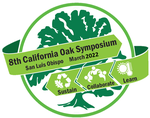#26

Do soil microbes affect drought tolerance in Quercus lobata? A field and greenhouse study of oak drought responses in the Tehachapi Mountains, CA.
Laura Bogar, Department of Ecology, Evolution, and Marine Biology, University of California-Santa Barbara
Ronja Keeley, Department of Ecology, Evolution, and Marine Biology, University of California-Santa Barbara
Gabe Runte, An Bui, Oceana Tavasieff, Carina Motta, and Holly Moeller; Department of Ecology, Evolution, and Marine Biology, University of California-Santa Barbara
Oaks, like nearly all plants, rely on soil microorganisms to improve access to water, unlock recalcitrant nutrients, and reduce their susceptibility to pathogenic infections. As the climate of California becomes warmer and drier, these partnerships with soil microbes like ectomycorrhizal fungi will become even more essential for oaks, especially at the seedling stage, when drought stress and pathogen pressure can be especially severe. This talk will present findings from two studies undertaken in the Moeller Lab at UCSB. In the first study, we used a natural climatic gradient in the Tehachapi Mountains to study how the ectomycorrhizal associates of valley oak (Quercus lobata) varied with aridity. We collected soil samples from below the canopies of fifty-three trees, sequenced DNA to identify members of the fungal community, and used trait databases to map fungal species identity to functional roles. We found that fungal traits mapped to environmental conditions. As rainfall decreased and trees experienced more arid (and stressful) conditions, they associated with fungal partners capable of gathering and transporting resources over longer distances. In the second study, we inoculated oak seedlings with soils from the same sites and subjected them to drought stress. We measured seedling physiology and growth, and are extracting DNA to determine if fungal traits affected seedling growth outcomes. Soil microbes are a key mediator of oak physiology across life stages, and understanding how climate may shift the functioning of these soil communities is essential to forecasting the future of oak woodlands in California and beyond.
